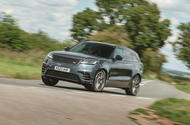Mid-life update for mid-sized Range Rover feels a little like tweaking for its own sake but leaves behind a car still well capable of a luxurious air
The Range Rover Velar may not be the industry-typical image of a mid-sized, mid-level SUV, but it is precisely that for JLR’s luxury SUV arm – which tells you as much about Range Rover as a modern sub-brand as it does about the car itself. Now in middle age as a first-generation model, the car is a high-style alternative to the likes of the Mercedes GLC, BMW X3 and Audi Q5 – and its latest update, though a fairly mild one, turns up the dial on its designer SUV credentials just a little.Having been introduced to UK showrooms in 2017, the Velar was the model with which Land Rover really focused on style. JLR design supremo Gerry McGovern seized the opportunity of a blank canvas to create a car not simply to plug the hole in the model range between Evoque and Range Rover Sport, but to explore the potential of the Range Rover brand to appeal to customers looking for a really standout design – and who would value that design every bit as much as Range Rover’s more traditional values of space, capability and luxury.It has sold well, and integrated within the Range Rover model range equally well, as its sibling models around it have themselves picked up a little of its reflected design star quality. Now, JLR has taken the opportunity to refresh its exterior a little, to improve its powertrain options slightly, and to reappraise its interior and infotainment technology rather more extensively.Under the skin, the Range Rover Velar remains unequivocally ‘car based’. Its predominately aluminium platform is the same architecture used by the Jaguar XE and Jaguar XF, while the Jaguar F-Pace is an even closer blood relative.Naturally, four-wheel drive and Land Rover’s Terrain Response system are both standard, even at the base of the line-up – but so, too, are four-cylinder engines, coil suspension, and a fairly low ride height (for a Range Rover, at least). At the other extreme of the derivative range, however, six-cylinder turbocharged engines promise plenty of Range Rover typical power, refinement and capability; adaptively damped, ride-height-adjustable air suspension adds plenty of dynamic versatility; and a petrol-electric PHEV version offers tax efficiency for fleet users.The Range Rover Velar line-up at a glanceThe UK-market Velar model range has been cut down a little, to two petrol and two diesel models, plus a four-cylinder petrol-electric PHEV. The P250 uses Land Rover’s turbocharged four-cylinder Ingenium petrol, while the D200 use a similarly split 2.0-litre diesel motor.The D300 and P400 have latest-generation turbocharged straight-six Ingenium engines, while the P400e mixes an electric motor with a four-pot petrol engine.Trim levels kick off with the Velar S, progressing upwards through Dynamic SE, Dynamic HSE and Autobiography; and the car’s richest items of equipment and more lavish cabin materials are reserved for the last two.







